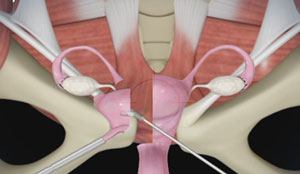Robotic-Assisted Gynecology Surgery

What is Robotic-Assisted Gynecologic Surgery?
Robotic-assisted gynecologic surgery is a minimally invasive surgical technique used to treat and repair various gynecologic conditions with the aid of a robotic operating system such as the da Vinci robotic system.
The da Vinci Surgical System is a robotic tool that offers improved magnification and viewing of the surgical site and greater precision that helps surgeons to make small, precise surgical cuts to carefully remove tissue while preserving structures of the internal female reproductive system, such as the uterus, ovaries, fallopian tubes, cervix, and vagina.
Due to the advancement in medical science and technology, the field of robotic surgery has developed exponentially and has broadened the scope of minimally invasive gynecological surgery, compelling gynecologic surgeons to consider robotic-assisted gynecologic surgery for various gynecologic conditions, such as uterine cancer, uterine fibroids, endometriosis, and uterine prolapse.
Indications and Contraindications
Today, robotic technology has been widely indicated to perform a variety of gynecological procedures, including:
- Hysterectomy for gynecologic cancer
- Myomectomy for removal of fibroids from the uterus
- Sacrocolpopexy for treating pelvic organ prolapse
- Adnexal surgery for removal of cysts, tumors, or adhesions in the uterus
- Malignancy staging
- Lymph node dissections
Any woman who is fit and healthy is a suitable candidate for robotic-assisted gynecologic surgery; however, it may not be appropriate for everyone. You should consult with your doctor to determine whether robotic surgery is right for you.
Procedure
Most of the complex gynecologic surgical procedures can be performed with the da Vinci robotic system. The da Vinci® robotic surgical system offers a minimally invasive alternative option to traditional open and laparoscopic surgery.
The da Vinci® surgical system consists of a surgeon’s console, a patient-side cart with four interactive robotic arms, a high-performance vision system (3D camera), and miniaturized EndoWrist surgical instruments.
While performing the surgical procedure, your surgeon will be seated at the da Vinci® console and is able to view a magnified, high-resolution 3D image of the area to be operated. To access the surgical site, your surgeon introduces miniaturized instruments through a few tiny incisions. These instruments help your surgeon perform the procedure with precision and control. Your surgeon uses master controls that function similar to forceps and in turn da Vinci® responds by immediate translation of the surgeon’s directions into precise movements of miniaturized instruments.
Postoperative Care and Instructions
Post-procedure care and instructions for robotic-assisted gynecologic surgery will include the following steps:
- You will be transferred to the recovery area where you will be asleep until the anesthesia wears off.
- You may notice some pain in the pelvis or abdomen area once you gain consciousness. Pain medications will be prescribed to alleviate pain.
- You may notice mild to moderate bloating for some days as a result of anesthesia and surgery. Anti-gas medications will be prescribed to relieve the discomfort.
- You will feel some discomfort and increased fatigue as a result of surgery. You are advised to eat a healthy diet and drink lots of water to speed up the healing.
- Refrain from strenuous activities and heavy lifting for a 4-6 weeks.
- Refrain from sexual activity for at least 6-8 weeks if you have undergone a hysterectomy. Specific instructions will be provided by your doctor.
- You can usually return to work in a couple of weeks unless your work involves strenuous activity or heavy lifting, in which case, it is advised to wait for 6 weeks.
- Adherence to scheduled follow-up appointments to monitor your progress.
Benefits
Gynecologic surgery with a robotic system offers several benefits over the traditional open surgery, including:
- Less pain
- Low risk of wound infection
- Less blood loss
- Less scarring
- Shorter hospital stay
- Faster recovery
- Fewer complications
- Fewer requirements in blood transfusions
Risks and Complications
Robotic-assisted gynecologic surgeries are relatively a safe option for treating gynecologic conditions; however, as with all surgeries, it does have some risks associated with it, including:
- Bleeding
- Infection
- Damage to nerves, vessels, and adjacent organs
- Mechanical malfunction
Related Topics
- Colpocleisis
- Pessary Fitting
- Clomid/Letrazole
- Uterine Septoplasty
- Office Hysteroscopy
- Cervical Biopsy
- Colposcopy
- Endometrial Ablation
- Endometrial Biopsy
- Excision of endometriosis
- Laparoscopy
- Hormone Replacement Therapy (HRT)
- Hysterectomy
- Hysteroscopy
- Intrauterine Device (IUD)
- Laparoscopic Ovarian Cystectomy
- LEEP
- Mona Lisa Touch
- Myomectomy
- Nexplanon
- Pre-conception Planning
- Robotic-Assisted Gynecology Surgery
- Sterilizations
- In-office Ultrasound
- In-office Procedures
